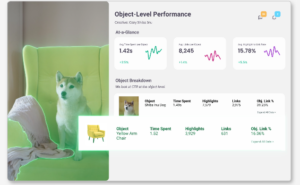These articles have been written by the latest cohort of the Practice Makes Unperfect programme – a course that helps women find and finesse their public voices.
By Tania Fedorchenko, Product Manager, A Million Ads
Data is one of the most important assets a business can have. In fact, talking about being data-driven has become so mainstream it’s hard to imagine a company that didn’t get on board in some way.
Yet, according to the Harvard Business Review Latest Survey, a lot of organisations still struggle with getting all the benefits from their data, which they attribute to lack of skills/training, company culture limiting the use of data or insufficient prioritisation.
(It’s worth noting, the majority of HBR respondents are mid-size or large organisations that have necessary resources, whilst startups might have even lower rates of utilizing analytics.)
So why is there so much mystery surrounding the space, and as a newcomer to the industry, why is it so daunting to get started?
In my experience, when you’re a product manager, you’re likely to find yourself in one of the following situations:
- You’re working in a big company that’s got all the tools but doesn’t know how to use them. So all you need to do is to nudge.
- You work at a company that has resources but your boss doesn’t see the value in analytics.
- You’re working for a small startup that has no time, capacity and, ugh, any real desire to think about data. On top of that, you’ve never introduced or set up any analytics before and you don’t know how to convince the business it’s necessary.
In each of these scenarios, it’s essential to know how to use and talk about data in the right way, whilst navigating the buzzwords, cliches and general pushback to a data strategy. Here are some of the examples of pushback I’ve encountered:
“You can’t measure everything!” Such a false dichotomy is, unfortunately, quite common to deal with. The answer is quite simple – yes, you won’t be able to measure all the things but you also don’t need to! Decisions made with half information are still likely to be more accurate than decisions made with no information at all.
“We don’t have enough users to look at numbers!” Maybe. But it doesn’t mean you can’t get any data at all. Quantitative data is not the only form of data. Don’t get stuck with analytics: it’s a way, not the way. Online surveys, polls, usability testing, in-depth user interviews are all your data too! Studies show that 5 people is enough to show you patterns.
“Customers don’t know what they want until you show them!” True, users might not know what an ideal solution to their problem could be, but only they can tell you what the problem is in the first place.
So what’s the best way to get started with a data-driven strategy when you don’t have any data yet?
- Start with setting the right goals.
Defining the right goals is key to understanding what you actually need to build and how you can measure it.
Imagine you’re an online education platform and you want to introduce search by filters to your courses, e.g. category, level, duration, etc. Initially, you thought you’d need to support a minimum of 10 filters for all the courses’ features. But if your goal is to help people find courses quicker and, therefore, increase the probability of conversion to purchase – you might only need category, price & rating filters to start with.
- If you can’t measure anything right now, start at least thinking about how you would if you had all the tools you need.
Imagine the same online education platform but this time you want to introduce categories to the courses on your website, like business, data science, arts, etc. If the goal is to help users find the right course quicker, let’s try putting some metrics around that. As we’re basically measuring an UX improvement, we might want to know:
- time spent from the start of the session to the purchase, that we’d expect to decrease
- customers’ reviews that we’d expect to improve
However, the real key question people might miss here is “So what?” Well, helping users to find the needed course quicker increase their chance of buying. This is how your goals become a lot more sensible. As of now, the most important thing you need to measure is your conversion to purchase.
- Once your goals are set and you thought of your ideal metric, think of how you can get the same information without tracking events.
In our example, it’d be harder to measure time spent searching on the website without tracking user interactions with website elements. However, getting the number of purchases is definitely something your finance or engineer peers could help you with. To get additional user data, you could put a poll on your website to find out if filtering was helpful to your customers.
- Remember you don’t need to start big.
Quite often, people avoid introducing analytics as it costs money, effort and feels like a really big change. But there’s no need to spend months defining and adding all the possible tracking. Instead, add new metrics little by little on demand. Or start with the key metrics that cover most of your needs at the start.
For a courses aggregator platform key metrics could be conversion to purchase and retention. Start with tracking those. It’ll also help you to make sure the changes you make are not negatively impacting the product.
- When you start getting your data, share it with colleagues
This strengthens your arguments plus eventually they might become more inclined to use data themselves. From my own experience: when I told one of my previous teams that we had 30% of mobile traffic on our website, pushing for a mobile version project became easier to sell and get my colleagues excited about!
For as long as you don’t study your own data, most probably you’re making steps in a random direction. Introducing any type of research or analytics can feel huge, risky and scary, but take these baby steps and your measurement and management will feel a lot more informed and a lot less daunting.









